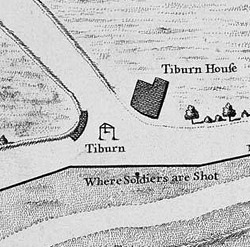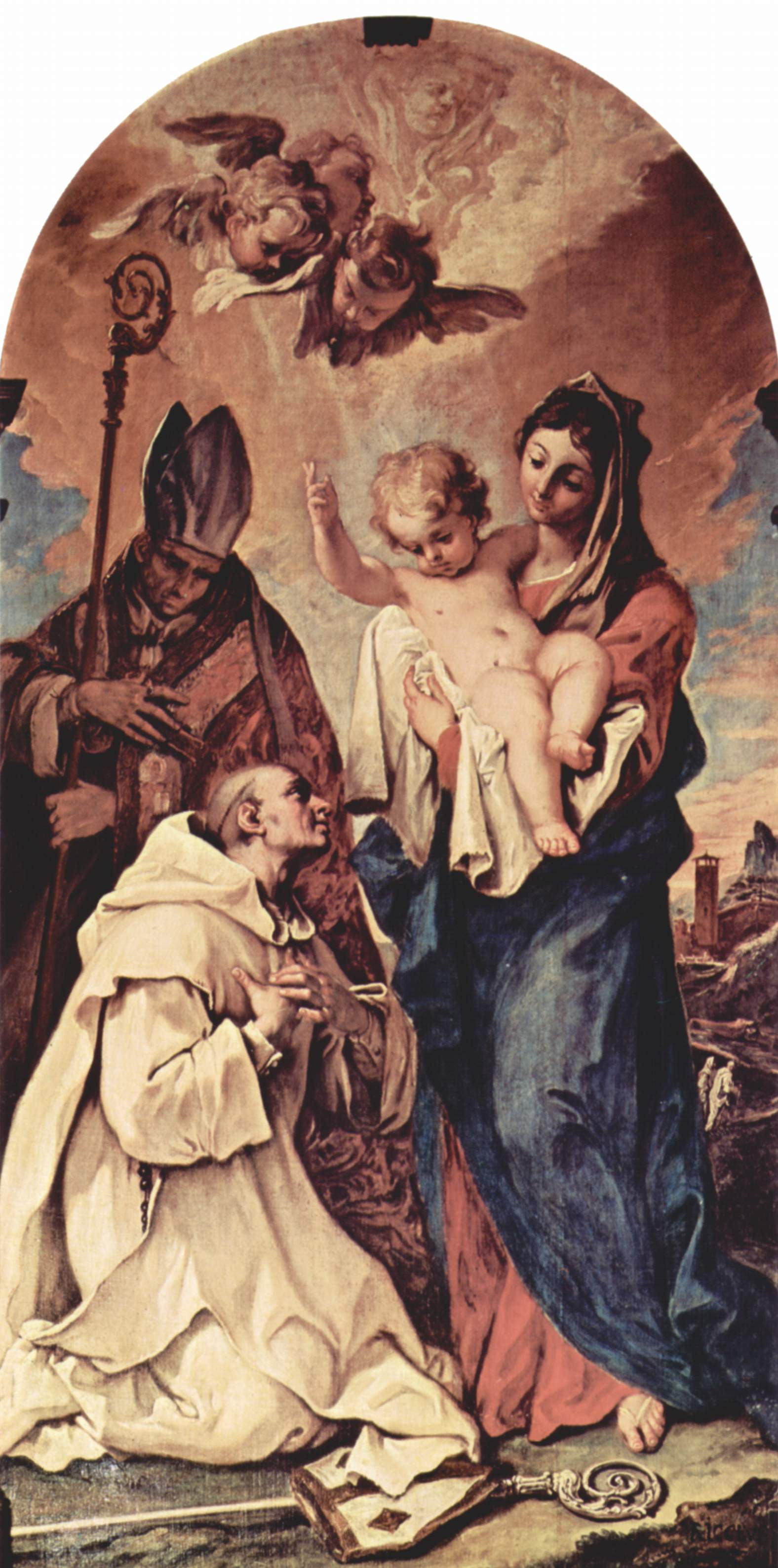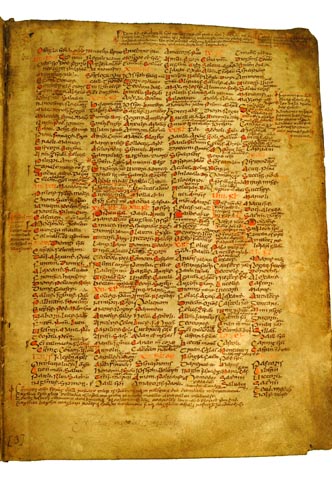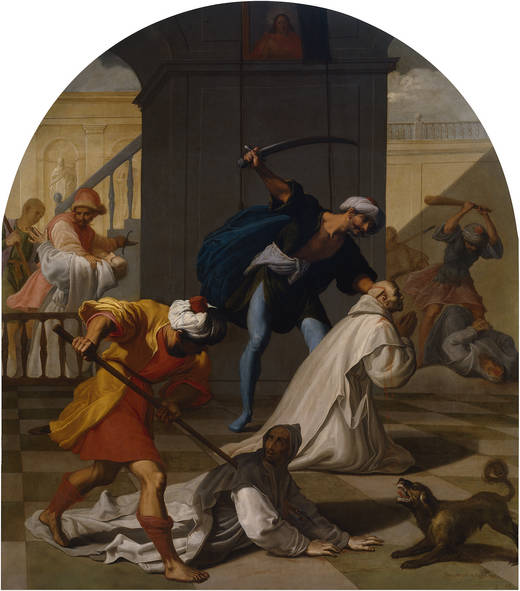|
Robert Lawrence (martyr)
Robert Lawrence, OCart (died 4 May 1535) was one of the Forty Martyrs of England and Wales. He was hanged, drawn, and quartered at Tyburn for declining to sign the Oath of Supremacy. His feast day is 4 May. Life Born about 1485, Robert Lawrence was a graduate of Cambridge. After joining the Carthusians, in 1531, he succeeded John Houghton as Prior of the Beauvale Priory, Nottinghamshire, when Houghton was appointed Prior of the London Charterhouse. By February 1535 Parliament declared that everyone had to take the Oath of Supremacy, declaring King Henry VIII to be Supreme Head of the Church of England. Lawrence went with Houghton to see Thomas Cromwell, who had them arrested and placed in the Tower of London. When they refused to sign the Oath of Supremacy, they were hanged, drawn and quartered at Tyburn, making them among the first Carthusian martyrs in England. Beatified in 1886, Robert was canonized by Pope Paul VI with thirty-nine other martyrs on 25 October 1970. See ... [...More Info...] [...Related Items...] OR: [Wikipedia] [Google] [Baidu] |
Pope Leo XIII
Pope Leo XIII (; born Gioacchino Vincenzo Raffaele Luigi Pecci; 2March 181020July 1903) was head of the Catholic Church from 20 February 1878 until his death in July 1903. He had the fourth-longest reign of any pope, behind those of Peter the Apostle, Pius IX (his immediate predecessor), and Pope John Paul II, John Paul II. Born in Carpineto Romano, near Rome, Leo XIII is well known for his intellectualism and his attempts to define the position of the Catholic Church with regard to modern thinking. In his 1891 Papal encyclical, encyclical ''Rerum novarum'', Pope Leo outlined the Workers rights, rights of workers to a fair wage, Occupational safety and health, safe working conditions, and the formation of trade unions, while affirming the rights to property and Market economy, free enterprise, opposing both Atheism, atheistic socialism and ''laissez-faire'' capitalism. With that encyclical, he became popularly called the "Social Pope" and the "Pope of the Workers", also having cr ... [...More Info...] [...Related Items...] OR: [Wikipedia] [Google] [Baidu] |
Tyburn, London
Tyburn was a Manorialism, manor (estate) in London, Middlesex, England, one of two which were served by the parish of Marylebone. Tyburn took its name from the Tyburn Brook, a tributary of the River Westbourne. The name Tyburn, from Teo Bourne (stream), Bourne, means 'boundary stream'.Gover, J. E. B., Allen Mawer and F. M. Stenton ''The Place-Names of Middlesex''. Nottingham: English Place-Name Society, The, 1942: 6. The parish, and probably therefore also the manor, was bounded by Roman roads to the west (modern Edgware Road) and south (modern Oxford Street). The junction of these was the site of the famous Tyburn Gallows (known colloquially as the "Tyburn Tree"), now occupied by Marble Arch. For many centuries the name Tyburn was synonymous with capital punishment: it was the principal place for execution for London and Middlesex criminals and convicted Treason, traitors, including many religious martyrs. In the 18th century it was also known as "God's Tribunal". Hangings at ... [...More Info...] [...Related Items...] OR: [Wikipedia] [Google] [Baidu] |
16th-century Roman Catholic Martyrs
The 16th century began with the Julian year 1501 (represented by the Roman numerals MDI) and ended with either the Julian or the Gregorian year 1600 (MDC), depending on the reckoning used (the Gregorian calendar introduced a lapse of 10 days in October 1582). The Renaissance in Italy and Europe saw the emergence of important artists, authors and scientists, and led to the foundation of important subjects which include accounting and political science. Copernicus proposed the heliocentric universe, which was met with strong resistance, and Tycho Brahe refuted the theory of celestial spheres through observational measurement of the 1572 appearance of a Milky Way supernova. These events directly challenged the long-held notion of an immutable universe supported by Ptolemy and Aristotle, and led to major revolutions in astronomy and science. Galileo Galilei became a champion of the new sciences, invented the first thermometer and made substantial contributions in the fields of phy ... [...More Info...] [...Related Items...] OR: [Wikipedia] [Google] [Baidu] |
16th-century Christian Saints
The 16th century began with the Julian calendar, Julian year 1501 (represented by the Roman numerals MDI) and ended with either the Julian or the Gregorian calendar, Gregorian year 1600 (MDC), depending on the reckoning used (the Gregorian calendar introduced a lapse of 10 days in October 1582). The Renaissance in Italy and Europe saw the emergence of important artists, authors and scientists, and led to the foundation of important subjects which include accounting and political science. Copernicus proposed the Copernican heliocentrism, heliocentric universe, which was met with strong resistance, and Tycho Brahe refuted the theory of celestial spheres through observational measurement of the SN 1572, 1572 appearance of a Milky Way supernova. These events directly challenged the long-held notion of an immutable universe supported by Ptolemy and Aristotle, and led to major revolutions in astronomy and science. Galileo Galilei became a champion of the new sciences, invented the first ... [...More Info...] [...Related Items...] OR: [Wikipedia] [Google] [Baidu] |
People Executed By Tudor England By Hanging, Drawing And Quartering
The term "the people" refers to the public or common mass of people of a polity. As such it is a concept of human rights law, international law as well as constitutional law, particularly used for claims of popular sovereignty. In contrast, a people is any plurality of persons considered as a whole. Used in politics and law, the term "a people" refers to the collective or community of an ethnic group or nation. Concepts Legal Chapter One, Article One of the Charter of the United Nations states that "peoples" have the right to self-determination. Though the mere status as peoples and the right to self-determination, as for example in the case of Indigenous peoples (''peoples'', as in all groups of indigenous people, not merely all indigenous persons as in ''indigenous people''), does not automatically provide for independent sovereignty and therefore secession. Indeed, judge Ivor Jennings identified the inherent problems in the right of "peoples" to self-determination, as i ... [...More Info...] [...Related Items...] OR: [Wikipedia] [Google] [Baidu] |
Carthusian Saints
The Carthusians, also known as the Order of Carthusians (), are a Latin enclosed religious order of the Catholic Church. The order was founded by Bruno of Cologne in 1084 and includes both monks and nuns. The order has its own rule, called the ''Statutes'', and their life combines both eremitical and cenobitic monasticism. The motto of the Carthusians is , Latin for "The Cross is steady while the world turns." The Carthusians retain a unique form of liturgy known as the Carthusian Rite. The name ''Carthusian'' is derived from the Chartreuse Mountains in the French Prealps: Bruno built his first hermitage in a valley of these mountains. These names were adapted to the English '' charterhouse'', meaning a Carthusian monastery. Today, there are 23 charterhouses, 18 for monks and 5 for nuns. The alcoholic cordial Chartreuse has been produced by the monks of Grande Chartreuse since 1737, which gave rise to the name of the color, though the liqueur is in fact produced not only as g ... [...More Info...] [...Related Items...] OR: [Wikipedia] [Google] [Baidu] |
English Roman Catholic Saints
English usually refers to: * English language * English people English may also refer to: Culture, language and peoples * ''English'', an adjective for something of, from, or related to England * ''English'', an Amish term for non-Amish, regardless of ethnicity * English studies, the study of English language and literature Media * ''English'' (2013 film), a Malayalam-language film * ''English'' (novel), a Chinese book by Wang Gang ** ''English'' (2018 film), a Chinese adaptation * ''The English'' (TV series), a 2022 Western-genre miniseries * ''English'' (play), a 2022 play by Sanaz Toossi People and fictional characters * English (surname), a list of people and fictional characters * English Fisher (1928–2011), American boxing coach * English Gardner (born 1992), American track and field sprinter * English McConnell (1882–1928), Irish footballer * Aiden English, a ring name of Matthew Rehwoldt (born 1987), American former professional wrestler ... [...More Info...] [...Related Items...] OR: [Wikipedia] [Google] [Baidu] |
Canonizations By Pope Paul VI
In various religions, a saint is a revered person who has achieved an eminent status of holiness, known as sainthood. The word ''saint'' comes from the Latin word , meaning , and although ''saint'' has been applied in other religious contexts, the word has its origins in Christianity. In Christianity, some religious authorities require that a person undergo a formal process of canonization to be recognized as a saint, such as the Catholic and Eastern Orthodox Churches. These churches also hold that a saint may intercede on behalf of the living who invoke them in prayer, a belief which is rejected by Protestants. Outside Christianity, the word ''saint'' has been extended to include revered figures in Buddhism, Chinese folk religion, Greek polytheism, Hinduism, Islam, Jainism, Judaism, Shinto, and Zoroastrianism. Christianity Interdenominational * Child * Early Christian * Military * Royal * By patronage ** Ailments, illness, and dangers ** Ethnic groups ** Occupation and ... [...More Info...] [...Related Items...] OR: [Wikipedia] [Google] [Baidu] |
1535 Deaths
Year 1535 ( MDXXXV) was a common year starting on Friday of the Julian calendar. Events January–March * January 18 – Lima, now the capital of Peru, is founded by Francisco Pizarro, as '' Ciudad de los Reyes''. * January 21 – The French Protestant leaders of the October 1534 '' Affaire des Placards'' are burned to death in front of the Cathedral of Notre-Dame de Paris and witnessed by a large crowd that includes King François and the visiting Ottoman diplomats. * February 27 – George Joye publishes his ''Apologye'' in Antwerp, to clear his name from the accusations of William Tyndale. * March 10 – Fray Tomás de Berlanga discovers the Galápagos Islands, when blown off course ''en route'' to Peru. * March 23 – English forces under William Skeffington storm Maynooth Castle in Ireland, the stronghold of Thomas FitzGerald, 10th Earl of Kildare, after a siege that began on March 16. Skeffington shows little mercy to the 25 surviving ... [...More Info...] [...Related Items...] OR: [Wikipedia] [Google] [Baidu] |
Year Of Birth Missing
A year is a unit of time based on how long it takes the Earth to orbit the Sun. In scientific use, the tropical year (approximately 365 solar days, 5 hours, 48 minutes, 45 seconds) and the sidereal year (about 20 minutes longer) are more exact. The modern calendar year, as reckoned according to the Gregorian calendar, approximates the tropical year by using a system of leap years. The term 'year' is also used to indicate other periods of roughly similar duration, such as the lunar year (a roughly 354-day cycle of twelve of the Moon's phasessee lunar calendar), as well as periods loosely associated with the calendar or astronomical year, such as the seasonal year, the fiscal year, the academic year, etc. Due to the Earth's axial tilt, the course of a year sees the passing of the seasons, marked by changes in weather, the hours of daylight, and, consequently, vegetation and soil fertility. In temperate and subpolar regions around the planet, four seasons are ... [...More Info...] [...Related Items...] OR: [Wikipedia] [Google] [Baidu] |
Carthusian Martyrs
The Carthusian martyrs are those members of the Carthusian monastic order who have been persecuted and killed because of their Christian faith and their adherence to the Catholic religion. As an enclosed order the Carthusians do not, on principle, put forward causes for their members, though causes have been promoted by others on their behalf. The order The Carthusian order was founded in 1084 by Saint Bruno of Cologne, and is an eremitic order, holding to the principle of withdrawal from the world to a life of silent contemplation and prayer. They are often viewed as hermits that live in common, having no active apostolate outside their Charterhouse. Carthusian life is dramatically different as compared to Benedictine Monasticism, the most prevalent form in the west. Today the Carthusians are a small order comprising 25 houses worldwide with just 350 male and 75 female members. The Martyrs During the Hussite Revolution in Bohemia in the 15th century Carthusian houses, as with ... [...More Info...] [...Related Items...] OR: [Wikipedia] [Google] [Baidu] |








